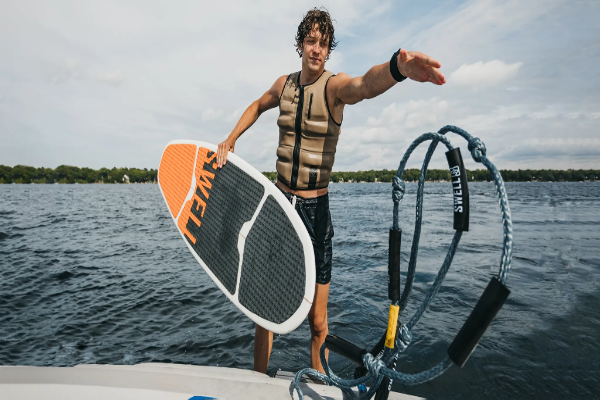Kneeboarding is an exciting water sport that combines elements of surfing, water skiing, and wakeboarding. It offers a thrilling experience on the water, suitable for all ages and skill levels. However, getting up on a kneeboard without a hook can be challenging, especially for beginners. This comprehensive guide will provide step-by-step instructions, tips, and techniques to help you master the skill of getting up on a kneeboard without using a hook.
What is Kneeboarding?
Kneeboarding involves riding a buoyant board on your knees while being towed behind a boat. It is an excellent entry-level water sport because it is easier to learn than wakeboarding or water skiing. Kneeboarders can perform various tricks and maneuvers once they become more experienced, making it a versatile and fun activity.
Understanding the Equipment
Before you start kneeboarding, it’s essential to familiarize yourself with the equipment:
- Kneeboard: This is a specialized board designed for kneeboarding. It typically has a padded surface for comfort and a strap to secure your knees.
- Tow Rope: A strong, durable rope connects the kneeboarder to the boat. The rope length can vary, but a standard length is around 65-75 feet.
- Life Jacket: Safety is paramount in any water sport. Always wear a properly fitted life jacket.
Choosing the Right Kneeboard
Selecting the right kneeboard is crucial for your success and enjoyment. There are two main types of kneeboards: recreational and competitive.
- Recreational Kneeboards: These are ideal for beginners and casual kneeboarders. They are more buoyant, stable, and easier to control.
- Competitive Kneeboards: These boards are designed for advanced riders who want to perform tricks and maneuvers. They are less buoyant and more responsive.
See Also: How to Bodyboarding with Fins
Safety First
Safety should always be your top priority when engaging in water sports. Here are some essential safety tips for kneeboarding:
- Wear a Life Jacket: Always wear a properly fitted life jacket to ensure your safety in the water.
- Check the Equipment: Regularly inspect your kneeboard, tow rope, and other gear for any signs of wear and tear.
- Know the Water Conditions: Be aware of the water conditions, including tides, currents, and any potential hazards.
- Communicate with the Boat Driver: Establish clear communication signals with the boat driver to ensure a smooth and safe ride.
Step-by-Step Guide to Getting Up on a Kneeboard Without a Hook
- Preparation: Position yourself in the water with your knees on the kneeboard and the tow rope handle in your hands. The board should be perpendicular to the boat.
- Grip the Handle: Hold the tow rope handle firmly with both hands. Your arms should be straight, and your grip should be relaxed but secure.
- Position Your Knees: Place your knees on the padded surface of the kneeboard. Your knees should be close together, and your weight should be evenly distributed.
- Stay Relaxed: Keep your body relaxed and maintain a slight bend in your knees. This position will help you balance and absorb any bumps or waves.
- Signal the Boat Driver: Use a clear hand signal to let the boat driver know you are ready to start.
- Let the Boat Pull You Up: As the boat starts to move, let the boat’s momentum pull you up. Keep your arms straight and allow the tow rope to lift you onto the board.
- Find Your Balance: Once you are up on the board, focus on finding your balance. Keep your knees bent, your back straight, and your eyes looking ahead.
- Use Your Core Muscles: Engage your core muscles to maintain stability and control. Your core will help you stay balanced and absorb any shocks from the water.
- Practice Turning: Once you are comfortable riding straight, practice turning by shifting your weight and using your knees to steer the board.
- Stay Hydrated: Kneeboarding can be physically demanding, so stay hydrated and take breaks as needed.
Common Mistakes to Avoid
- Tensing Up: Staying relaxed is crucial for balance and control. Avoid tensing up, which can make it harder to stay on the board.
- Looking Down: Keep your eyes looking ahead, not down at the board. Looking down can throw off your balance.
- Ignoring Safety: Always prioritize safety. Wear a life jacket, check your equipment, and be aware of your surroundings.
Advanced Tips and Techniques
- Crossing the Wake: Once you are comfortable on the board, try crossing the boat’s wake. This maneuver can be challenging but adds excitement to your ride.
- Performing Tricks: As you gain confidence and skill, experiment with tricks such as 360-degree spins, surface tricks, and jumps.
- Improving Balance: Practice yoga or balance exercises to improve your stability on the kneeboard.
- Building Strength: Strengthen your core, legs, and upper body with targeted exercises to enhance your kneeboarding performance.
Conclusion
Kneeboarding without a hook is a rewarding challenge that can provide endless fun and excitement on the water. By following this comprehensive guide, you can master the skill and enjoy the thrill of kneeboarding to its fullest. Remember to stay safe, practice regularly, and most importantly, have fun!

